Yufei He
Enabling Self-Improving Agents to Learn at Test Time With Human-In-The-Loop Guidance
Jul 23, 2025Abstract:Large language model (LLM) agents often struggle in environments where rules and required domain knowledge frequently change, such as regulatory compliance and user risk screening. Current approaches, like offline fine-tuning and standard prompting, are insufficient because they cannot effectively adapt to new knowledge during actual operation. To address this limitation, we propose the Adaptive Reflective Interactive Agent (ARIA), an LLM agent framework designed specifically to continuously learn updated domain knowledge at test time. ARIA assesses its own uncertainty through structured self-dialogue, proactively identifying knowledge gaps and requesting targeted explanations or corrections from human experts. It then systematically updates an internal, timestamped knowledge repository with provided human guidance, detecting and resolving conflicting or outdated knowledge through comparisons and clarification queries. We evaluate ARIA on the realistic customer due diligence name screening task on TikTok Pay, alongside publicly available dynamic knowledge tasks. Results demonstrate significant improvements in adaptability and accuracy compared to baselines using standard offline fine-tuning and existing self-improving agents. ARIA is deployed within TikTok Pay serving over 150 million monthly active users, confirming its practicality and effectiveness for operational use in rapidly evolving environments.
Efficient Reasoning via Chain of Unconscious Thought
May 26, 2025Abstract:Large Reasoning Models (LRMs) achieve promising performance but compromise token efficiency due to verbose reasoning processes. Unconscious Thought Theory (UTT) posits that complex problems can be solved more efficiently through internalized cognitive processes. Inspired by UTT, we propose a new reasoning paradigm, termed Chain of Unconscious Thought (CoUT), to improve the token efficiency of LRMs by guiding them to mimic human unconscious thought and internalize reasoning processes. Concretely, we first prompt the model to internalize the reasoning by thinking in the hidden layer. Then, we design a bag of token-efficient strategies to further help models reduce unnecessary tokens yet preserve the performance. Our work reveals that models may possess beneficial unconscious thought, enabling improved efficiency without sacrificing performance. Extensive experiments demonstrate the effectiveness of CoUT. Remarkably, it surpasses CoT by reducing token usage by 47.62% while maintaining comparable accuracy, as shown in Figure 1. The code of CoUT is available at this link: https://github.com/Rohan-GRH/CoUT
MLR-Bench: Evaluating AI Agents on Open-Ended Machine Learning Research
May 26, 2025Abstract:Recent advancements in AI agents have demonstrated their growing potential to drive and support scientific discovery. In this work, we introduce MLR-Bench, a comprehensive benchmark for evaluating AI agents on open-ended machine learning research. MLR-Bench includes three key components: (1) 201 research tasks sourced from NeurIPS, ICLR, and ICML workshops covering diverse ML topics; (2) MLR-Judge, an automated evaluation framework combining LLM-based reviewers with carefully designed review rubrics to assess research quality; and (3) MLR-Agent, a modular agent scaffold capable of completing research tasks through four stages: idea generation, proposal formulation, experimentation, and paper writing. Our framework supports both stepwise assessment across these distinct research stages, and end-to-end evaluation of the final research paper. We then use MLR-Bench to evaluate six frontier LLMs and an advanced coding agent, finding that while LLMs are effective at generating coherent ideas and well-structured papers, current coding agents frequently (e.g., in 80% of the cases) produce fabricated or invalidated experimental results--posing a major barrier to scientific reliability. We validate MLR-Judge through human evaluation, showing high agreement with expert reviewers, supporting its potential as a scalable tool for research evaluation. We open-source MLR-Bench to help the community benchmark, diagnose, and improve AI research agents toward trustworthy and transparent scientific discovery.
FlowReasoner: Reinforcing Query-Level Meta-Agents
Apr 21, 2025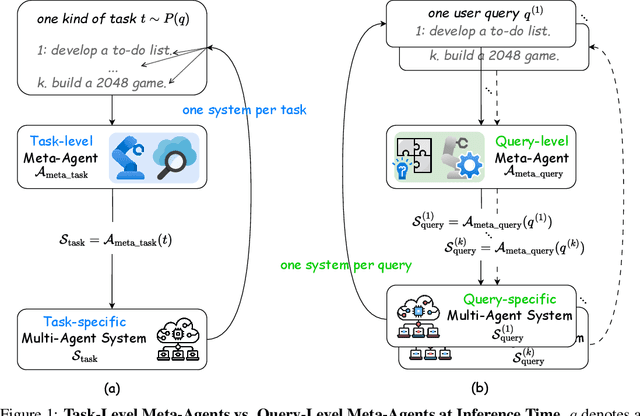
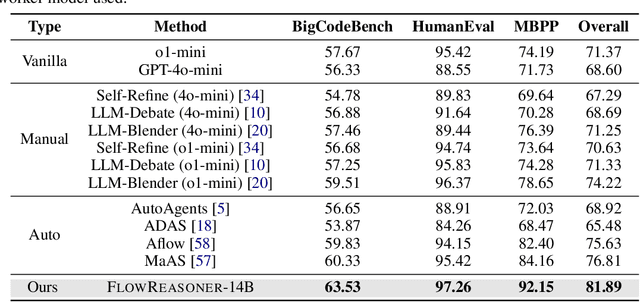
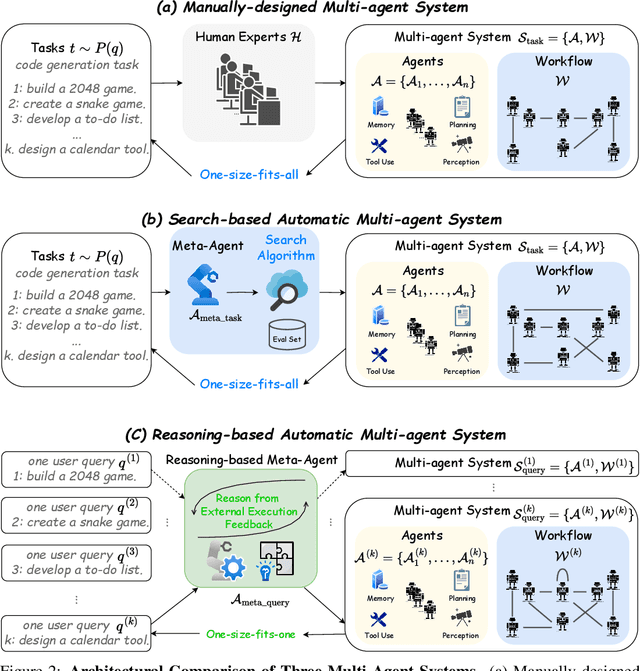

Abstract:This paper proposes a query-level meta-agent named FlowReasoner to automate the design of query-level multi-agent systems, i.e., one system per user query. Our core idea is to incentivize a reasoning-based meta-agent via external execution feedback. Concretely, by distilling DeepSeek R1, we first endow the basic reasoning ability regarding the generation of multi-agent systems to FlowReasoner. Then, we further enhance it via reinforcement learning (RL) with external execution feedback. A multi-purpose reward is designed to guide the RL training from aspects of performance, complexity, and efficiency. In this manner, FlowReasoner is enabled to generate a personalized multi-agent system for each user query via deliberative reasoning. Experiments on both engineering and competition code benchmarks demonstrate the superiority of FlowReasoner. Remarkably, it surpasses o1-mini by 10.52% accuracy across three benchmarks. The code is available at https://github.com/sail-sg/FlowReasoner.
Efficient Inference for Large Reasoning Models: A Survey
Mar 29, 2025
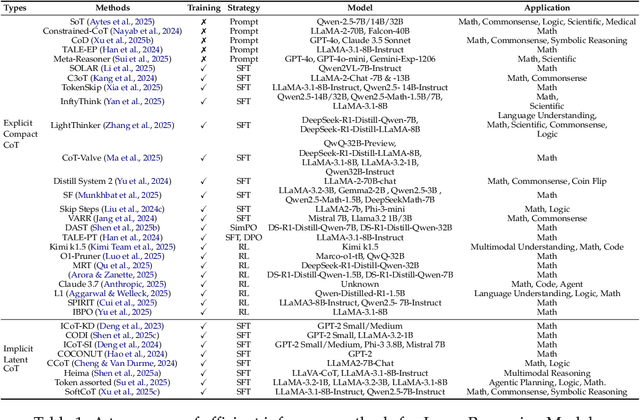
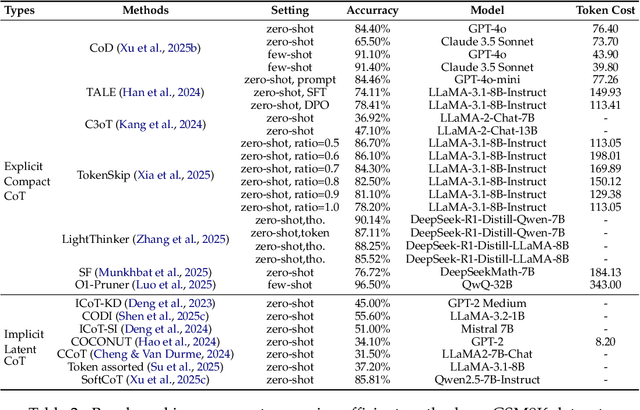
Abstract:Large Reasoning Models (LRMs) significantly improve the reasoning ability of Large Language Models (LLMs) by learning to reason, exhibiting promising performance in complex task-solving. However, their deliberative reasoning process leads to inefficiencies in token usage, memory consumption, and inference time. Thus, this survey provides a review of efficient inference methods designed specifically for LRMs, focusing on mitigating token inefficiency while preserving the reasoning quality. First, we introduce a taxonomy to group the recent methods into two main categories: (a) explicit compact Chain-of-Thought (CoT), which reduces tokens while keeping the explicit reasoning structure, and (b) implicit latent CoT, which encodes reasoning steps within hidden representations instead of explicit tokens. Meanwhile, we discuss their strengths and weaknesses. Then, we conduct empirical analyses on existing methods from performance and efficiency aspects. Besides, we present open challenges in this field, including human-centric controllable reasoning, trade-off between interpretability and efficiency of reasoning, ensuring safety of efficient reasoning, and broader applications of efficient reasoning. In addition, we highlight key insights for enhancing LRMs' inference efficiency via techniques such as model merging, new architectures, and agent routers. We hope this work serves as a valuable guide, helping researchers overcome challenges in this vibrant field\footnote{https://github.com/yueliu1999/Awesome-Efficient-Inference-for-LRMs}.
Meta-Reasoner: Dynamic Guidance for Optimized Inference-time Reasoning in Large Language Models
Feb 27, 2025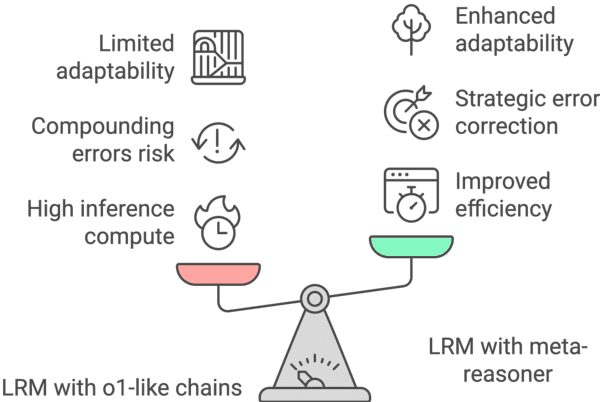
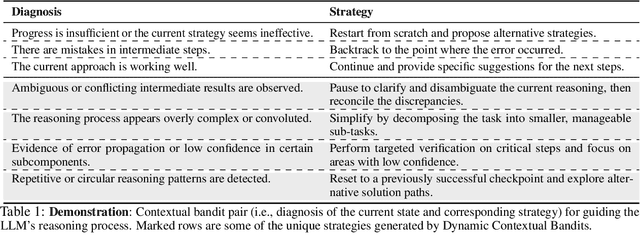
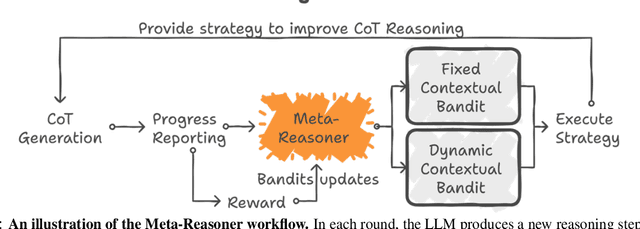
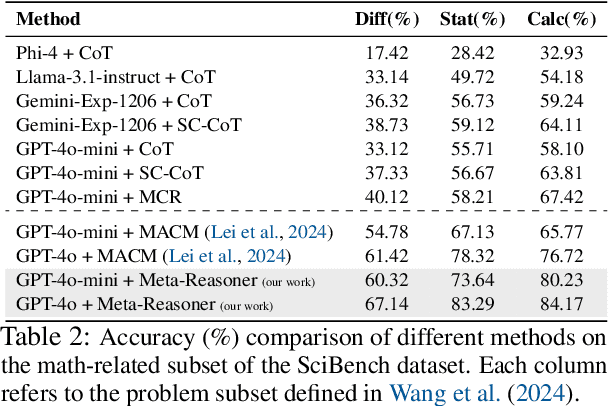
Abstract:Large Language Models (LLMs) increasingly rely on prolonged reasoning chains to solve complex tasks. However, this trial-and-error approach often leads to high computational overhead and error propagation, where early mistakes can derail subsequent steps. To address these issues, we introduce Meta-Reasoner, a framework that dynamically optimizes inference-time reasoning by enabling LLMs to "think about how to think." Drawing inspiration from human meta-cognition and dual-process theory, Meta-Reasoner operates as a strategic advisor, decoupling high-level guidance from step-by-step generation. It employs "contextual multi-armed bandits" to iteratively evaluate reasoning progress, and select optimal strategies (e.g., backtrack, clarify ambiguity, restart from scratch, or propose alternative approaches), and reallocates computational resources toward the most promising paths. Our evaluations on mathematical reasoning and puzzles highlight the potential of dynamic reasoning chains to overcome inherent challenges in the LLM reasoning process and also show promise in broader applications, offering a scalable and adaptable solution for reasoning-intensive tasks.
UniGraph2: Learning a Unified Embedding Space to Bind Multimodal Graphs
Feb 02, 2025



Abstract:Existing foundation models, such as CLIP, aim to learn a unified embedding space for multimodal data, enabling a wide range of downstream web-based applications like search, recommendation, and content classification. However, these models often overlook the inherent graph structures in multimodal datasets, where entities and their relationships are crucial. Multimodal graphs (MMGs) represent such graphs where each node is associated with features from different modalities, while the edges capture the relationships between these entities. On the other hand, existing graph foundation models primarily focus on text-attributed graphs (TAGs) and are not designed to handle the complexities of MMGs. To address these limitations, we propose UniGraph2, a novel cross-domain graph foundation model that enables general representation learning on MMGs, providing a unified embedding space. UniGraph2 employs modality-specific encoders alongside a graph neural network (GNN) to learn a unified low-dimensional embedding space that captures both the multimodal information and the underlying graph structure. We propose a new cross-domain multi-graph pre-training algorithm at scale to ensure effective transfer learning across diverse graph domains and modalities. Additionally, we adopt a Mixture of Experts (MoE) component to align features from different domains and modalities, ensuring coherent and robust embeddings that unify the information across modalities. Extensive experiments on a variety of multimodal graph tasks demonstrate that UniGraph2 significantly outperforms state-of-the-art models in tasks such as representation learning, transfer learning, and multimodal generative tasks, offering a scalable and flexible solution for learning on MMGs.
Generalizing Graph Transformers Across Diverse Graphs and Tasks via Pre-Training on Industrial-Scale Data
Jul 04, 2024Abstract:Graph pre-training has been concentrated on graph-level on small graphs (e.g., molecular graphs) or learning node representations on a fixed graph. Extending graph pre-trained models to web-scale graphs with billions of nodes in industrial scenarios, while avoiding negative transfer across graphs or tasks, remains a challenge. We aim to develop a general graph pre-trained model with inductive ability that can make predictions for unseen new nodes and even new graphs. In this work, we introduce a scalable transformer-based graph pre-training framework called PGT (Pre-trained Graph Transformer). Specifically, we design a flexible and scalable graph transformer as the backbone network. Meanwhile, based on the masked autoencoder architecture, we design two pre-training tasks: one for reconstructing node features and the other one for reconstructing local structures. Unlike the original autoencoder architecture where the pre-trained decoder is discarded, we propose a novel strategy that utilizes the decoder for feature augmentation. We have deployed our framework on Tencent's online game data. Extensive experiments have demonstrated that our framework can perform pre-training on real-world web-scale graphs with over 540 million nodes and 12 billion edges and generalizes effectively to unseen new graphs with different downstream tasks. We further conduct experiments on the publicly available ogbn-papers100M dataset, which consists of 111 million nodes and 1.6 billion edges. Our framework achieves state-of-the-art performance on both industrial datasets and public datasets, while also enjoying scalability and efficiency.
FiDeLiS: Faithful Reasoning in Large Language Model for Knowledge Graph Question Answering
May 22, 2024Abstract:While large language models (LLMs) have achieved significant success in various applications, they often struggle with hallucinations, especially in scenarios that require deep and responsible reasoning. These issues could be partially mitigate by integrating external knowledge graphs (KG) in LLM reasoning. However, the method of their incorporation is still largely unexplored. In this paper, we propose a retrieval-exploration interactive method, FiDelis to handle intermediate steps of reasoning grounded by KGs. Specifically, we propose Path-RAG module for recalling useful intermediate knowledge from KG for LLM reasoning. We incorporate the logic and common-sense reasoning of LLMs and topological connectivity of KGs into the knowledge retrieval process, which provides more accurate recalling performance. Furthermore, we propose to leverage deductive reasoning capabilities of LLMs as a better criterion to automatically guide the reasoning process in a stepwise and generalizable manner. Deductive verification serve as precise indicators for when to cease further reasoning, thus avoiding misleading the chains of reasoning and unnecessary computation. Extensive experiments show that our method, as a training-free method with lower computational cost and better generality outperforms the existing strong baselines in three benchmarks.
UniGraph: Learning a Cross-Domain Graph Foundation Model From Natural Language
Feb 21, 2024Abstract:Foundation models like ChatGPT and GPT-4 have revolutionized artificial intelligence, exhibiting remarkable abilities to generalize across a wide array of tasks and applications beyond their initial training objectives. However, when this concept is applied to graph learning, a stark contrast emerges. Graph learning has predominantly focused on single-graph models, tailored to specific tasks or datasets, lacking the ability to transfer learned knowledge to different domains. This limitation stems from the inherent complexity and diversity of graph structures, along with the different feature and label spaces specific to graph data. In this paper, we present our UniGraph framework, designed to train a graph foundation model capable of generalizing to unseen graphs and tasks across diverse domains. Unlike single-graph models that use pre-computed node features of varying dimensions as input, our approach leverages Text-Attributed Graphs (TAGs) for unifying node representations. We propose a cascaded architecture of Language Models (LMs) and Graph Neural Networks (GNNs) as backbone networks with a self-supervised training objective based on Masked Graph Modeling (MGM). We introduce graph instruction tuning using Large Language Models (LLMs) to enable zero-shot prediction ability. Our comprehensive experiments across various graph learning tasks and domains demonstrate the model's effectiveness in self-supervised representation learning on unseen graphs, few-shot in-context transfer, and zero-shot transfer, even surpassing or matching the performance of GNNs that have undergone supervised training on target datasets.
 Add to Chrome
Add to Chrome Add to Firefox
Add to Firefox Add to Edge
Add to Edge